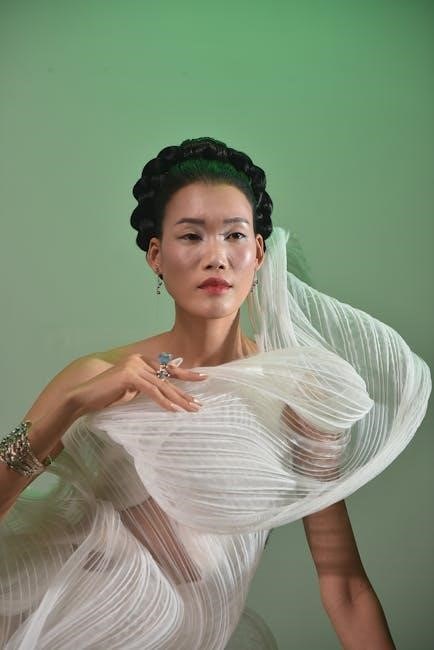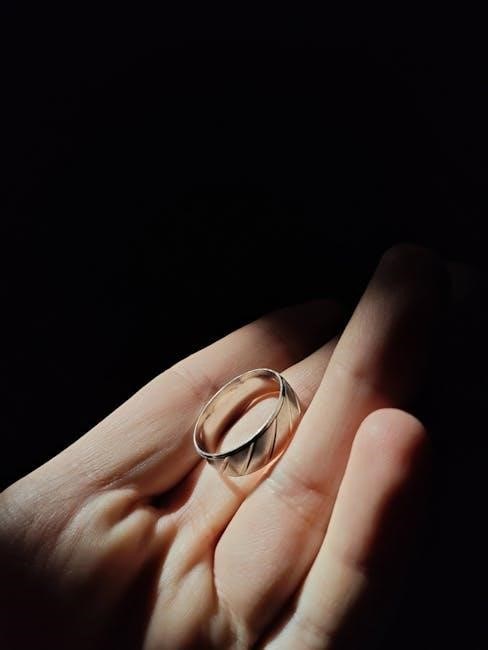Understanding Ring Slings
A ring sling is a versatile baby carrier made from a long piece of fabric with two rings sewn at one end. It allows for easy adjustments to create a snug, comfortable fit for both caregiver and baby. Ideal for newborns and toddlers, it promotes hands-free parenting while keeping your little one close and secure.

What is a Ring Sling?

A ring sling is a type of baby carrier made from a long piece of fabric, typically ranging in length from 1.8 to 2 meters, with two aluminum rings sewn into one end. This design allows for easy adjustments, creating a snug and secure pouch for carrying a baby. The rings serve as a mechanism to tighten or loosen the fabric, ensuring a customizable fit for both the caregiver and the baby.
The fabric used for ring slings varies, with popular options including Tencel blends, 100% cotton, and bamboo. These materials are chosen for their breathability, softness, and durability, making them comfortable for extended use. The sling is worn over one shoulder, with the baby typically positioned on the opposite hip. This asymmetric design distributes the baby’s weight comfortably, though it is recommended to switch shoulders periodically, especially for older or heavier babies.
Ring slings are highly versatile and can be used from the newborn stage up to toddler age, with weight limits generally around 35 pounds. They are particularly popular for their ease of use and compact design, making them ideal for quick errands or outings. The adjustable nature of the sling ensures that it can grow with the child, providing a comfortable and secure carrying option for years.
The sling’s length is a matter of personal preference, with longer tails offering additional support or serving as a makeshift nursing cover. Overall, a ring sling is a practical and stylish way to keep your baby close while keeping your hands free for other tasks.
Benefits of Using a Ring Sling
A ring sling offers numerous benefits for both caregivers and babies, making it a popular choice for daily use. One of the most significant advantages is its versatility. It can be used from the newborn stage up to toddler age, with weight limits generally around 35 pounds. This makes it a long-lasting investment for growing families.
The adjustable design of the ring sling allows for a customizable fit, ensuring comfort for both the wearer and the baby. The fabric can be tightened or loosened easily, providing a snug and secure position for the baby while distributing the weight evenly across the caregiver’s shoulder and back. This adjustability also makes it suitable for different body types and preferences.
Ring slings are also incredibly convenient. They are quick to put on and take off, making them ideal for running errands, traveling, or any situation where a fast and easy babywearing solution is needed. The compact design of the sling means it can be easily stowed away in a bag when not in use.
Another benefit is the variety of carrying positions it offers. While the most common position is on the hip, ring slings can also be used for front carries or even back carries with practice. This versatility allows caregivers to choose the position that feels most comfortable for them and their baby.
Additionally, the fabric options for ring slings, such as Tencel blends, cotton, and bamboo, are known for their breathability and softness, ensuring comfort during extended use. Longer slings also provide extra fabric that can be used for additional support, as a nursing cover, or simply for style.
Overall, a ring sling is a practical, comfortable, and stylish way to keep your baby close while maintaining freedom of movement. Its ease of use, adjustability, and versatility make it a favorite among many parents.

Choosing the Right Ring Sling
Selecting the perfect ring sling involves considering fabric type, size, and personal comfort. Opt for breathable materials like Tencel, cotton, or bamboo for softness and durability. Choose a size that fits your body, with longer slings offering additional versatility. Ensure the sling is appropriate for your baby’s age and weight, and prioritize comfort for extended use.
Size Chart and Fit
Proper fit is essential for comfort and safety when using a ring sling. The sling should be snug but not overly tight, allowing easy adjustments to accommodate your baby’s position. Size charts vary by brand, so refer to the manufacturer’s guidelines to ensure the best fit. Typically, sizes range from Small to Extra-Large, corresponding to the length of the sling. A well-fitted sling should distribute the baby’s weight evenly, with the fabric laying flat across your back.
When choosing a size, consider your height and body type. Taller individuals may prefer longer slings for better coverage and support, while shorter individuals might opt for a more compact fit. The sling should also accommodate your baby’s age and size, ensuring they are securely positioned with proper support.
Adjustments should be made gradually, starting with the rings and moving down the fabric. This ensures a comfortable and secure fit for both you and your baby. Always check that the fabric is not twisted and lies smoothly across your back. If the sling feels too tight or restrictive, loosen it slightly to allow for a natural range of motion.
Remember, a good fit enhances the overall babywearing experience, providing comfort and confidence for both caregiver and baby. Always refer to the specific size chart provided by the manufacturer to ensure the best possible fit for your needs.
Fabric Types and Materials
When choosing a ring sling, the fabric type plays a crucial role in comfort, durability, and overall babywearing experience. Common materials include cotton, Tencel, bamboo, linen, and blends. Each fabric offers unique benefits, so it’s important to select one that suits your lifestyle and preferences.

100% cotton is a popular choice for its softness, breathability, and ease of use. It is ideal for beginners and works well in most climates. However, cotton slings may lack the structure needed for heavier babies or toddlers.
For a softer and more luxurious feel, Tencel blends are highly recommended. Tencel is known for its moisture-wicking properties and gentle texture, making it perfect for sensitive skin. Many parents swear by Tencel slings for their comfort and stylish appearance.
Bamboo fabrics are lightweight, breathable, and eco-friendly, making them a great option for warm weather. They are also naturally antimicrobial, which is a plus for busy parents. However, bamboo slings may be less durable than other materials over time.
Linen slings are another excellent choice, especially for older babies and toddlers. Linen is strong, supportive, and cooling, though it can feel stiff initially until broken in. With proper care, linen slings become soft and comfortable while maintaining their structural integrity;
Blends, such as cotton-linen or Tencel-cotton mixes, combine the best qualities of different fabrics. These slings often offer the perfect balance of softness, support, and durability.

When selecting a fabric, consider factors like your baby’s age, weight, and your climate; Lighter fabrics are ideal for newborns and summer, while denser materials like linen are better for older babies and cooler weather. Always ensure the fabric is safe and comfortable for your baby, with no harsh chemicals or irritants. By choosing the right material, you can enhance your babywearing experience and enjoy the convenience of a ring sling.

Preparing the Ring Sling
To prepare your ring sling, start by gathering the fabric and threading it through the rings. Ensure the fabric is not twisted and lies flat. Adjust the sling to fit snugly, starting with it mostly tightened. Check that the material is smooth and even, with no slack or bunching. This ensures a secure and comfortable fit for your baby.
Threading the Sling
Threading the ring sling is the first step in preparing it for use. To begin, locate the two rings sewn at the top of the sling. Hold the rings in one hand and gently pull the fabric through them with the other. Ensure the fabric is not twisted as it passes through the rings. Once the fabric is threaded, pull it back over one of the rings to create a secure loop. This loop will form the pouch where your baby will sit. Next, gather any excess fabric and tuck it under the rings to keep it tidy. It’s important to make sure the fabric lies flat and is evenly spread across your back for optimal comfort and support. If the fabric is bunched or twisted, adjust it by gently pulling it through the rings until it lies smoothly. Proper threading ensures that the sling is secure and comfortable for both you and your baby. Take your time and practice this step until it feels natural. Once the sling is properly threaded, you can move on to adjusting the fit and ensuring proper tightness.

Adjusting the Fit
Adjusting the fit of a ring sling is crucial for both comfort and safety. Start by ensuring the sling is threaded correctly, with the fabric lying flat and untwisted across your back. Once your baby is placed inside, gently pull the fabric to create a snug and secure fit. The rings allow for precise adjustments, so you can tighten or loosen the fabric as needed.
To achieve the perfect fit, begin by pulling any slack in the fabric through the rings. This will help create a comfortable pouch for your baby. Ensure the fabric is evenly distributed across your back, avoiding any bunching or twisting. If the sling feels too loose, tighten it by pulling the fabric through the rings in small increments. If it feels too tight, gently loosen it by sliding the fabric back through the rings.
Proper positioning is key. Your baby should be seated deeply in the sling, with their knees slightly higher than their bum to support their natural M-shaped position. The fabric should extend from the crook of one knee to the crook of the other, providing adequate support for their bottom and thighs. For newborns, ensure the fabric is tight enough to support their neck and back while allowing for easy breathing.
For older babies, you can adjust the sling to allow more room in the seat while maintaining safety. Always check that the fabric is snug but not overly restrictive. If you’re nursing or need extra coverage, longer tails can be adjusted to provide additional support or privacy. Remember, practice makes perfect, so take your time to fine-tune the fit until it feels comfortable for both you and your baby.
Ensuring Proper Tightness
Ensuring proper tightness in a ring sling is essential for both safety and comfort. A well-adjusted sling will keep your baby secure while allowing for easy breathing and movement. Start by threading the sling correctly, making sure the fabric is flat and untwisted. Once your baby is placed inside, gently pull the fabric through the rings to tighten the pouch.
To achieve the right tightness, check that the fabric is snug but not overly restrictive. Your baby should be able to move their arms and legs comfortably, and their chest should not be compressed. For newborns, ensure the fabric is tight enough to support their neck and back but loose enough to allow for proper breathing.
For older babies, the sling should still be snug, but you can allow a bit more room in the seat for their growing size. Always ensure the fabric is evenly distributed across your back and shoulders to avoid discomfort. If the sling feels too loose, tighten it by pulling the fabric through the rings in small increments. If it feels too tight, gently loosen it by sliding the fabric back through the rings.
Regularly check the tightness while wearing your baby, especially during extended use. Proper tightness ensures your baby is secure and comfortable, and it helps prevent strain on your shoulders and back. Remember, the goal is to create a safe and cozy environment for your baby while keeping yourself comfortable. With practice, you’ll find the perfect balance of tightness for both of you.
Final Checks Before Use
Before placing your baby in the ring sling, it’s crucial to perform a series of final checks to ensure everything is safe and secure. Start by inspecting the sling for any signs of wear, such as frayed edges or damaged rings. If you notice any damage, do not use the sling until it’s repaired.
Next, make sure the sling is properly threaded. The fabric should be looped through both rings and pulled back over one ring to create a secure hold. This ensures the sling won’t come loose while in use.

Once the sling is threaded, adjust the fit to ensure it’s snug but not overly tight. The fabric should be flat and untwisted across your back, with no bunching or wrinkles. This helps distribute the weight evenly and prevents discomfort during use.
Check the position of the rings. They should be high on your shoulder, with the fabric spread evenly across your back. For a newborn, the rings should be slightly lower to accommodate their smaller size.
Finally, ensure the baby’s position is correct. Their bottom should be deep in the pouch, with their knees slightly higher than their bum to support their natural M-shaped posture. The fabric should support their neck and back, especially for newborns.
After completing these checks, you’re ready to place your baby in the sling. Always prioritize your baby’s comfort and safety, and make adjustments as needed throughout use. Regular checks during wear will help maintain a secure and comfortable fit for both you and your baby.
Safety Tips for Using a Ring Sling
Always ensure the sling is secure and properly threaded before placing your baby inside. Check for fabric wear and damaged rings. Keep your baby’s face visible and uncovered for easy breathing. Ensure their knees are higher than their bum for proper support. Avoid loose fits and keep the sling snug. Regularly inspect the sling for damage.
General Safety Guidelines
Safe use of a ring sling begins with proper preparation and awareness. Always inspect the sling for any signs of wear, such as frayed edges or damaged rings, before each use. Ensure the sling is threaded correctly through the rings, following the manufacturer’s instructions, to avoid any structural issues.
When placing your baby in the sling, maintain a secure and snug fit. The fabric should be tightened evenly, with no twists or bunching behind the rings, as this can compromise the sling’s integrity. Keep your baby’s face visible and uncovered to ensure proper breathing and visibility. Avoid covering their face with excess fabric, especially during sleep.
Position your baby with their knees slightly higher than their bum to support their natural spine alignment and prevent strain. The sling should distribute the baby’s weight evenly across your shoulders and back to avoid discomfort or fatigue. Never leave the sling unattended while in use, especially near hazards like stairs or hot surfaces.
Additionally, be mindful of the sling’s material. Opt for breathable, non-toxic fabrics like cotton or bamboo to ensure comfort and safety for your baby’s sensitive skin. Avoid using the sling in extreme weather conditions without proper precautions, such as layering clothing for warmth or protection from the sun.
Finally, trust your instincts and seek guidance if you feel unsure about any aspect of using the ring sling. Many resources, including instructional videos and babywearing communities, are available to help you master safe and comfortable baby carrying. By following these guidelines, you can enjoy the benefits of a ring sling while keeping your baby safe and secure.
Proper Baby Positioning
Proper baby positioning in a ring sling is essential for comfort, safety, and healthy development. The goal is to create a secure, ergonomic seat that supports your baby’s body. Always ensure your baby is placed in a deep seat, where the fabric is pulled snugly across their bottom and thighs, from the crook of one knee to the crook of the other. This prevents them from sliding down and ensures proper weight distribution.

The baby’s knees should be slightly higher than their bum, forming an “M” shape with their legs. This position supports their natural spine alignment and prevents strain on their hips and joints. The fabric should also be adjusted to support their neck and head, especially for newborns, who lack the strength to hold their head up independently.
Ensure your baby’s face is always visible and uncovered while in the sling. Avoid letting the fabric cover their nose or mouth, as this can obstruct breathing. For younger babies, keep their head close to your chest, where you can easily monitor their airway.
The sling should be tightened in sections—top, middle, and bottom—to create a snug, even fit. This prevents the baby from leaning too far forward or backward and ensures the fabric is not bunched or twisted. Proper positioning not only keeps your baby comfortable but also helps distribute their weight evenly, reducing strain on your shoulders and back.
By maintaining proper positioning, you can enjoy the benefits of ring sling babywearing while keeping your baby safe and supported.
Weight and Age Limits
Ring slings are designed to accommodate babies from newborn stages up to toddlerhood, with weight limits typically ranging from 8 to 35 pounds (3.5 to 15.9 kilograms), depending on the fabric and construction. Newborns can generally be worn in a ring sling right away, provided there are no medical concerns, and the sling is properly positioned. For older babies and toddlers, the weight limit depends on the sling’s material and the caregiver’s comfort.
The age limit for using a ring sling extends into toddlerhood, with many parents continuing to use them until their child is around 2 years old. However, as babies grow heavier, it’s important to ensure the sling remains comfortable and supportive. Some parents switch to soft-structured carriers for older, heavier children, but ring slings remain a popular choice for quick, easy use.
It’s essential to check the manufacturer’s guidelines for specific weight and age recommendations, as these can vary. For example, slings made from sturdy materials like linen or Tencel blends may support higher weight limits compared to lighter fabrics. Additionally, proper threading and tightening of the sling are critical to ensure safety and comfort for both the baby and the wearer.
For newborns, ring slings are particularly convenient, as they allow for a snug, high carry that keeps the baby close and secure. As babies grow, the sling can be adjusted to accommodate their changing size and weight, ensuring continued safety and comfort. Always consult a medical professional before using a ring sling, especially if your baby has any health concerns or if you’re recovering from a C-section.
